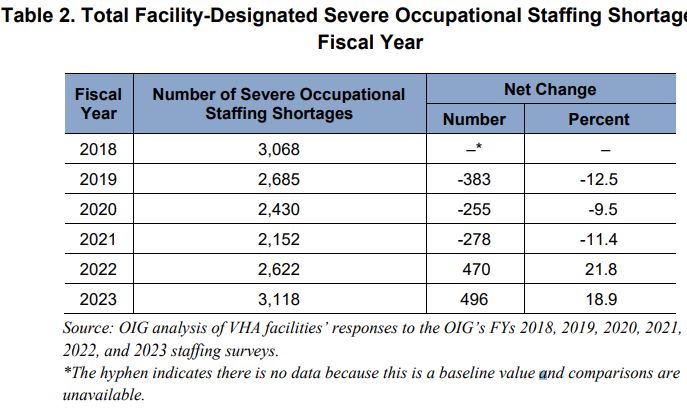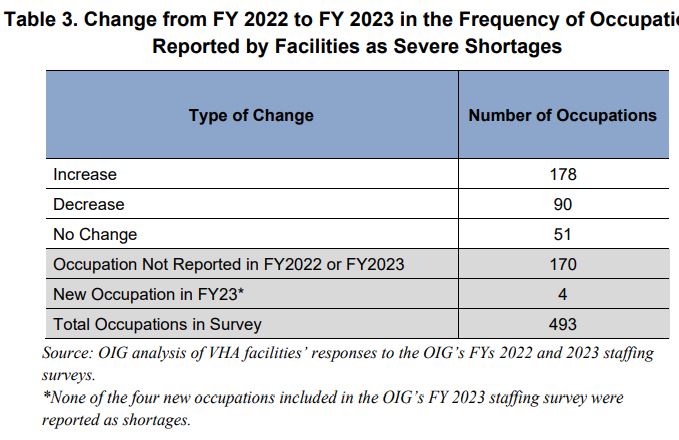WASHINGTON, DC — Despite a recent hiring surge, VA has been losing ground in filling key healthcare positions, with the number of severe shortages rising from this time last year.
According to a survey conducted by the VA Office of the Inspector General (OIG) in FY 2023, facilities reported 3,118 severe occupational staffing shortages across 282 occupations—an increase from 2,622 across 285 occupations in FY 2022. This follows annual decreases in severe shortages from 2018 to 2021, followed by a leap in 2022.
Both the pandemic and the PACT Act provided VA with new authorities designed to allow the department to fill positions more quickly. Emergency hiring provisions during the pandemic allowed VA to bring on staff in a matter of days and to put off much of the work of background checks until after the employees were in place. The PACT Act gives VA the ability to buy out providers’ old contracts, gives VA new flexibility in awarding bonuses, and provides other tools to fill staffing gaps in preparation for the surge of new patients the toxic exposure legislation already is bringing into the system.
VA officials have testified that the department has never hired more people in such a short amount of time, and announced recently that it has surpassed 400,000 employees for the first time in its history. Hiring has not kept pace with VA’s needs, however, the OIG found.
“The total number of severe occupational shortages increased, and some shortages persisted despite gains in onboard employees,” the survey report stated.
In some cases, already-existing shortages had worsened in the past year.
“Twenty-five occupations were identified as a severe occupational staffing shortage by at least 20% of facilities in FY 2023,” OIG staff noted. “This was an increase from 22 in FY 2022 and 19 in FY 2021.”
The occupations that saw the largest increase in facilities reporting a shortage in the last year were social work (44 facilities to 75 facilities reporting), pharmacy technician (26 to 45), psychology (73 to 91) and nursing assistant (53 to 70).
As for the professions that were reported by the greatest number of facilities, many are familiar from previous years’ surveys. The top clinical occupations with shortages were practical nurse (93% of facilities reporting a shortage), psychology (91%), social work (74%), psychiatry (73%) and nursing assistant (70%). The top nonclinical occupations were medical support assistance (97%), custodial worker (95%), food service worker (74%), police (73%) and general engineering (57%).
Of these, police, psychiatry, practical nurse and psychology have consistently been listed in the top five clinical and nonclinical severe shortages. However, VHA has experienced average annual net increases in onboard staffing levels in each of these occupations since 2018.
When looking at clinicians and nurses as a whole, the OIG found that, every year since 2014. Those occupations were identified as severe shortages. This year, 88% of facilities had severe shortages of clinicians, and 92% had severe shortages of nurses.
“Despite the ability to make non-competitive appointments for such occupations and annual net increases in onboard staffing levels since FY 2017, VHA continues to experience severe occupational staffing shortages for these occupations that are fundamental to the delivery of healthcare,” the OIG investigators wrote.
In his response to the report, VA Undersecretary for Health Shereef Elnahal, MD, touted the 4.9% growth of VHA employees in the first 9 months of 2023, representing 44,000 new hires. He also noted the realities of the current healthcare hiring market.
“Staffing shortages reflect occupations and specialties that are difficult to fill due to shortages in the available workforce, competition with the private sector or other factors and do not necessarily reflect the number of vacancies in those occupations,” Elnahal said. “It is also noteworthy that the results of the VHA national workforce planning cycle are largely consistent with the results of the OIG survey. VHA continues to diligently assess occupational staffing shortages and provide resources and support to the field to help reduce shortages, including the publication of shortage occupation blueprints with granular occupation-level analysis, hiring need projections and occupation-specific recruitment and retention strategies.”


